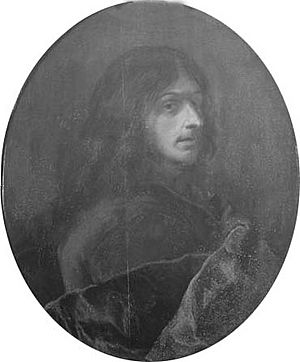Sébastien Bourdon facts for kids
Sébastien Bourdon (born February 2, 1616 – died May 8, 1671) was a talented French painter and engraver. One of his most famous paintings is The Crucifixion of St. Peter, which he created for the famous Notre Dame Cathedral in Paris.



Contents
Early Life and Artistic Journey
Sébastien Bourdon was born in Montpellier, France. His father was also an artist who painted on glass. When Sébastien was young, he moved to Paris and became an apprentice to another painter.
Even though he didn't have much money, he managed to travel to Rome in 1636. In Rome, he studied the works of famous artists. These included Nicolas Poussin, Claude Lorrain, and Caravaggio.
Leaving Rome and Returning to Paris
In 1638, Bourdon had to leave Rome quickly. He was a Protestant, and at that time, people with his religious beliefs faced difficulties. He feared being arrested because of his faith.
After leaving Rome, he lived in Paris for many years, from 1637 to 1652.
Founding the Royal Academy
In 1648, Sébastien Bourdon helped start an important art school. It was called the French Royal Academy of Painting and Sculpture. He was chosen as one of the first twelve leaders of this new academy. This showed how respected he was as an artist.
Working for a Queen
In 1652, Bourdon moved to Sweden. There, Christina of Sweden, who was the Queen, made him her main court painter. This was a very important job, as he painted portraits and other works for the Queen.
Bourdon's Diverse Art Styles
Sébastien Bourdon was known for being able to paint in many different styles. He was very good at painting portraits, sometimes in a lively way like Peter Paul Rubens. He also painted quieter, more personal portraits. These often showed people from the chest up against a plain background. This style became popular for middle-class portraits for many years.
He also painted landscapes, similar to the artist Gaspar Dughet. Sometimes he created scenes with old ruins, called "capricci." He painted mythological stories, like other artists who followed Nicolas Poussin. He even painted everyday scenes, similar to Dutch artists known as the Bamboccianti.
Because he used so many different styles, it can be hard to recognize a single "Bourdon style." However, his ability to adapt made him a very versatile artist.
Later Life and Legacy
Bourdon spent most of his career outside France. Even though he helped start the Royal Academy, his work was sometimes overlooked in his home country.
However, a big exhibition of his art in 2000 helped people appreciate his work more. This show was held at the Musée Fabre in Montpellier. This museum has a beautiful painting by him called Lamentation, which he painted near the end of his life.
Bourdon was so successful that he had a large workshop with many students. Some of his students included Nicolas-Pierre Loir and Pierre Mosnier. Sébastien Bourdon passed away in Paris in 1671.
See also
 In Spanish: Sébastien Bourdon para niños
In Spanish: Sébastien Bourdon para niños


